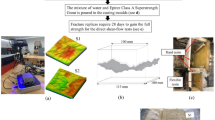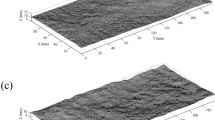Abstract
Extensive research has shown that fluid flow through rock fractures is greatly influenced by surface roughness. For a single rock fracture, the roughness of the upper and bottom surfaces is the same in the initial condition and then its deformation occurs with normal stress and shear stress imposed on the natural rock. Previous researchers have paid considerable attention to describing the roughness of the single fracture and its effects on fluid flow. However, few studies have explained the fluid flow with shear displacement and the direction of the fluid flow velocity field. In this work, a more detailed 2D numerical model was developed using a laser scanner system with a spacing grid of 0.1 mm. To investigate the influence of shear displacement accurately, the COMSOL multiphase codes were applied. By applying the Navier–Stokes equations, the results of the procedure for shear displacement simulation illustrate the distribution of the absolute velocity and pressure drop under the constant pressure gradient. The velocities predicted at the vertical profiles of the inlet were similar to the parabolic velocity curve defined by the cubic laws. The mean mechanical aperture was usually larger than the hydraulic aperture from the measured flow rates, and a devised empirical equation was proposed to describe the relationship between the mechanical aperture and the hydraulic aperture values. The recirculation zones observed in directional fluid flow during shear explain the anisotropy of roughness of a single fracture, and the phenomenon argues the applicability of local cubic laws which overestimate the total fluid flow rate.

















Similar content being viewed by others
Abbreviations
- b :
-
Vertical separation (mm)
- b m :
-
Mechanical aperture (arithmetic average of b) (mm)
- b h :
-
Hydraulic aperture (mm)
- d s :
-
Shear displacement (mm)
- L :
-
Total length of single fracture (mm)
- \(\varDelta p\) :
-
Fluid pressure (Pa)
- Q :
-
Volumetric flow velocity (mm2 s−1)
- u :
-
Absolute values of velocity (m/s)
- u x :
-
Values of velocity in x component (m/s)
- σ s :
-
Standard deviation of aperture (mm)
References
Amadei B, Illangasekare T (1994) A mathematical model for flow and solute transport in non-homogeneous rock fractures. In: International journal of rock mechanics and mining sciences and geomechanics abstracts, vol 6. Elsevier, pp 719–731
Boutt DF, Grasselli G, Fredrich JT, Cook BK, Williams JR (2006) Trapping zones: the effect of fracture roughness on the directional anisotropy of fluid flow and colloid transport in a single fracture. Geophys Res Lett. doi:10.1029/2006gl027275
Brown SR (1987) Fluid flow through rock joints: the effect of surface roughness. J Geophys Res Solid Earth 92:1337–1347. doi:10.1029/JB092iB02p01337
Brown SR, Stockman HW, Reeves SJ (1995) Applicability of the Reynolds equation for modeling fluid flow between rough surfaces. Geophys Res Lett 22:2537–2540. doi:10.1029/95GL02666
Cacace M et al (2013) Modelling of fractured carbonate reservoirs: outline of a novel technique via a case study from the Molasse Basin, southern Bavaria, Germany. Environ Earth Sci 70:3585–3602. doi:10.1007/s12665-013-2402-3
Chen Z, Narayan SP, Yang Z, Rahman SS (2000) An experimental investigation of hydraulic behaviour of fractures and joints in granitic rock. Int J Rock Mech Min Sci 37:1061–1071. doi:10.1016/S1365-1609(00)00039-3
Detwiler RL, Rajaram H, Glass RJ (2000) Solute transport in variable-aperture fractures: an investigation of the relative importance of Taylor dispersion and macrodispersion. Water Resour Res 36:1611–1625. doi:10.1029/2000wr900036
Esaki T, Du S, Mitani Y, Ikusada K, Jing L (1999) Development of a shear-flow test apparatus and determination of coupled properties for a single rock joint. Int J Rock Mech Min Sci 36:641–650. doi:10.1016/S0148-9062(99)00044-3
Eshiet KII, Sheng Y (2013) Carbon dioxide injection and associated hydraulic fracturing of reservoir formations. Environ Earth Sci 72:1011–1024. doi:10.1007/s12665-013-3018-3
Eshiet KI, Sheng Y, Ye J (2012) Microscopic modelling of the hydraulic fracturing process. Environ Earth Sci 68:1169–1186. doi:10.1007/s12665-012-1818-5
Grasselli G (2006) Manuel rocha medal recipient shear strength of rock joints based on quantified surface description. Rock Mech Rock Eng 39:295–314. doi:10.1007/s00603-006-0100-0
Grasselli G, Wirth J, Egger P (2002) Quantitative three-dimensional description of a rough surface and parameter evolution with shearing. Int J Rock Mech Min Sci 39:789–800. doi:10.1016/S1365-1609(02)00070-9
Huang Y, Tang Y, Zhou Z, Yu Z (2013) Experimental investigation of contaminant migration in filled fracture. Environ Earth Sci 71:1205–1211. doi:10.1007/s12665-013-2524-7
Huang Y, Zhou Z, Wang J, Dou Z (2014) Simulation of groundwater flow in fractured rocks using a coupled model based on the method of domain decomposition. Environ Earth Sci 72:2765–2777
Huenges E, Kohl T, Kolditz O, Bremer J, Scheck-Wenderoth M, Vienken T (2013) Geothermal energy systems: research perspective for domestic energy provision. Environ Earth Sci 70:3927–3933
Jiang Q, Ye Z, Yao C, Zhou C (2012) A new variational inequality formulation for unconfined seepage flow through fracture networks. Sci China Technol Sci 55:3090–3101
Jiang Q, Yao C, Ye Z, Zhou C (2013) Seepage flow with free surface in fracture networks. Water Resour Res 49:176–186
Jiang Q, Ye Z, Zhou C (2014) A numerical procedure for transient free surface seepage through fracture networks. J Hydrol 519:881–891
Ju Y, Zhang Q, Yang Y, Xie H, Gao F, Wang H (2013) An experimental investigation on the mechanism of fluid flow through single rough fracture of rock. Sci China Technol Sci 56:2070–2080. doi:10.1007/s11431-013-5274-6
Kissinger A et al (2013) Hydraulic fracturing in unconventional gas reservoirs: risks in the geological system, part 2. Environ Earth Sci 70:3855–3873. doi:10.1007/s12665-013-2578-6
Koyama T, Neretnieks I, Jing L (2008) A numerical study on differences in using Navier-Stokes and Reynolds equations for modeling the fluid flow and particle transport in single rock fractures with shear. Int J Rock Mech Mining Sci 45:1082–1101. doi:10.1016/j.ijrmms.2007.11.006
Li B, Jiang Y, Koyama T, Jing L, Tanabashi Y (2008) Experimental study of the hydro-mechanical behavior of rock joints using a parallel-plate model containing contact areas and artificial fractures. Int J Rock Mech Min Sci 45:362–375. doi:10.1016/j.ijrmms.2007.06.004
Marina S, Imo-Imo EK, Derek I, Mohamed P, Yong S (2014) Modelling of hydraulic fracturing process by coupled discrete element and fluid dynamic methods. Environ Earth Sci 72:3383–3399. doi:10.1007/s12665-014-3244-3
Matsuki K, Lee J-J, Sakaguchi K (1999) Size effect in flow conductance of a closed small-scale hydraulic fracture in granite. Geotherm Sci Technol 6:113–138
Matsuki K, Chida Y, Sakaguchi K, Glover PWJ (2006) Size effect on aperture and permeability of a fracture as estimated in large synthetic fractures. Int J Rock Mech Min Sci 43:726–755. doi:10.1016/j.ijrmms.2005.12.001
Matsuki K, Kimura Y, Sakaguchi K, Kizaki A, Giwelli AA (2010) Effect of shear displacement on the hydraulic conductivity of a fracture. Int J Rock Mech Min Sci 47:436–449. doi:10.1016/j.ijrmms.2009.10.002
Müller C, Siegesmund S, Blum P (2010) Evaluation of the representative elementary volume (REV) of a fractured geothermal sandstone reservoir. Environ Earth Sci 61:1713–1724. doi:10.1007/s12665-010-0485-7
Multiphysics C (2010) 4.1 User guide stockholm, Sweden
Plouraboué F, Hulin J-P, Roux S, Koplik J (1998) Numerical study of geometrical dispersion in self-affine rough fractures. Phys Rev E 58:3334–3346
Rasouli V, Hosseinian A (2011) Correlations developed for estimation of hydraulic parameters of rough fractures through the simulation of JRC flow channels. Rock Mech Rock Eng 44:447–461. doi:10.1007/s00603-011-0148-3
Renshaw CE (1995) On the relationship between mechanical and hydraulic apertures in rough-walled fractures. J Geophys Res Solid Earth 100:24629–24636. doi:10.1029/95JB02159
Scesi L, Gattinoni P (2006) Roughness control on hydraulic conductivity in fractured rocks. Hydrogeol J 15:201–211. doi:10.1007/s10040-006-0076-6
Silliman SE (1989) An interpretation of the difference between aperture estimates derived from hydraulic and tracer tests in a single fracture. Water Resour Res 25:2275–2283. doi:10.1029/WR025i010p02275
Thompson ME, Brown SR (1991) The effect of anisotropic surface roughness on flow and transport in fractures. J Geophys Res Solid Earth 96:21923–21932. doi:10.1029/91JB02252
Witherspoon PA, Wang JSY, Iwai K, Gale JE (1980) Validity of Cubic Law for fluid flow in a deformable rock fracture. Water Resour Res 16:1016–1024. doi:10.1029/WR016i006p01016
Xiong X, Li B, Jiang Y, Koyama T, Zhang C (2011) Experimental and numerical study of the geometrical and hydraulic characteristics of a single rock fracture during shear. Int J Rock Mech Min Sci 48:1292–1302. doi:10.1016/j.ijrmms.2011.09.009
Yeo IW, de Freitas MH, Zimmerman RW (1998) Effect of shear displacement on the aperture and permeability of a rock fracture. Int J Rock Mech Min Sci 35:1051–1070. doi:10.1016/S0148-9062(98)00165-X
Zhu H, Xie H, Yi C, Jiang Y (2013) Analysis of properties of fluid flow in rock fractures. Chin J Rock Mech Eng 32:657–663
Zimmerman RW, Bodvarsson GS (1996) Hydraulic conductivity of rock fractures. Transport Porous Media 23:1–30
Zimmerman RW, Yeo I-W (2013) Fluid flow in rock fractures: from the Navier-Stokes Equations to the Cubic Law. In: Dynamics of fluids in fractured rock. American geophysical union, pp 213–224. doi:10.1029/GM122p0213
Zimmerman RW, Al-Yaarubi A, Pain CC, Grattoni CA (2004) Non-linear regimes of fluid flow in rock fractures. Int J Rock Mech Min Sci 41:163–169
Acknowledgments
This work was financially supported by the Sichuan Provincial Science and Technology Support Project (2012FZ0124) and the International Science and Technology Cooperation Program of China (2012DFA60760).
Author information
Authors and Affiliations
Corresponding author
Rights and permissions
About this article
Cite this article
Xie, L.Z., Gao, C., Ren, L. et al. Numerical investigation of geometrical and hydraulic properties in a single rock fracture during shear displacement with the Navier–Stokes equations. Environ Earth Sci 73, 7061–7074 (2015). https://doi.org/10.1007/s12665-015-4256-3
Received:
Accepted:
Published:
Issue Date:
DOI: https://doi.org/10.1007/s12665-015-4256-3




